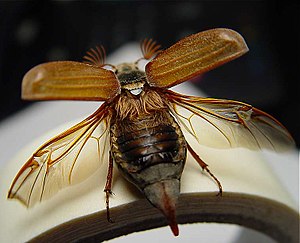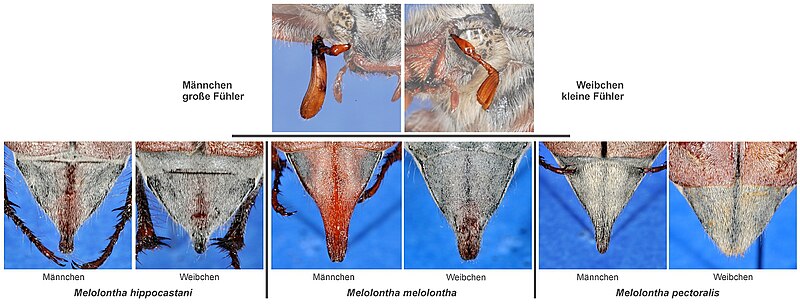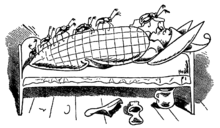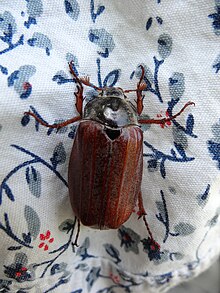Cockchafer
| Cockchafer | ||||||||||||
|---|---|---|---|---|---|---|---|---|---|---|---|---|

Cockchafer ( Melolontha melolontha ), ♂ on departure |
||||||||||||
| Systematics | ||||||||||||
|
||||||||||||
| Scientific name | ||||||||||||
| Melolontha | ||||||||||||
| Fabricius , 1775 |
The cockchafer ( Melolontha ) are a genus of beetles in the scarab beetle family ( Scarabaeidae ). The most common cockchafer in Central Europe is the field cockchafer ( Melolontha melolontha ). The forest cockchafer ( Melolontha hippocastani ) occurs on sandy soils in northern and eastern Europe and in some regions of Germany . A third species, very similar to the field cockchafer, is Melolontha pectoralis . It has become very rare and can only be found sporadically in Central Europe. There are only now and then reports from southwest Germany.
features
The cockchafer belong to the scarab beetle family , whose name is derived from the typical fan-shaped antennae . The antennae are much less pronounced in the females than in the males. The males have seven antennae plates that have around 50,000 olfactory nerves; in the females, on the other hand, the six-lobed antennae shows about 9000 of these nerves. The adults of the cockchafer reach a body length of 25 to 30 mm, depending on the nutritional conditions; the forest cockchafer is somewhat smaller (20-25 mm).
The three species occurring in Central Europe can best be distinguished by their abdominal tip ( Pygidium ): In Melolontha hippocastani, this is narrow in both sexes and ends in a nodular process that is sometimes missing in the female. In Melolontha melolontha , the tip of the abdomen is elongated in both sexes into a lancet-like process without knots and only finely haired, while in Melolontha pectoralis it is doubly hairy in both sexes and is slightly and narrowly elongated in the male, but truncated in the female.
Way of life
After the end of the metamorphosis , the cockchafer, true to its name, burrows out of the ground in April and May, mainly flies in May and June and feeds mainly on the leaves of deciduous trees . The beetles live as imago for about four to seven weeks. The male dies after mating, the female after laying eggs. When laying eggs, 10 to 100 eggs are placed in rather moist humus soil. The grubs hatch after four to six weeks .
Cockchafer have a cycle time of three to five, usually four years. This means that the newly hatched grubs need four years before they have undergone a complete metamorphosis into sexually mature animals. These cycles are regionally synchronized. In a four-year cycle, for example, three years with low incidence are followed by a year with significantly more beetles (cockchafer year) . A 30- to 45-year rhythm is superimposed on this cycle. The reasons for this are not known in detail. It is assumed, however, that diseases and parasites that specifically infect cockchafer beetles can spread epidemically unhindered in contiguous populations . Only when the infestation has severely decimated the beetles do the remaining beetles have a greater chance of staying healthy. In this way the longer cycles are created, at the end of which one of the infamous cockchafer plagues stands. When the cockchafer plague in 1911, around 22 million beetles were collected on an area of around 1,800 hectares.
Cockchafer and human
Gerdt von Bassewitz 's fairy tale Peterchens Mondfahrt tells of a cockchafer who goes on an adventurous journey with two human children. In the fifth chapter of Wilhelm Busch's story of Max and Moritz , the cockchafer play an essential role.
The two battalions of the Guard Fusilier Regiment met each year in May in Potsdam for exercise. The advancing 2nd Battalion was greeted by the boys looking for cockchafers with the shout "cockchafer" due to the colorful regimental uniform (red Swedish cuffs with white braid, yellow shoulder pieces, brown piping ). The name quickly carried over to the whole regiment and, after Friedrich Wilhelm IV. As Crown Prince, once addressed the regiment with “cockchafer”, it became almost official. This is why their barracks were also called the cockchafer barracks .
Until the 1960s, these beetles (sorted by chimney sweep, baker or emperor) were collected by children. Because of their appearance and the noise they make in flight, an encounter with a cockchafer is an impressive experience, especially for children. Maikäfer flieg is a well-known German-language folk and children's song.
However, their larvae (grubs) in particular are considered pests . While the beetles devour entire deciduous forests when there are large numbers of them, from which the trees recover, the larvae eat the roots, which means that deciduous trees and the like grow again. U. die out across the board. Whether one has to fight the cockchafer is therefore always controversial.
Reinhard Mey describes in the well-known song There are no cockchafer anymore (included in his album: As before year and day from 1974) the consequences of the massive control of cockchafer with the now banned insecticide DDT between the early 1950s and around 1972. However, even in areas where the cockchafer was not actively controlled, its population has declined sharply. In 1974 there was an artificial fungus growth of the cockchafer in France and then in Switzerland. In recent years, larger stocks have been reported from parts of Central Europe. In May 2010, for the first time in 55 years, several hundred hectares of forest were treated with an insecticide against cockchafer in the southern Hessian municipality of Pfungstadt to combat cockchafer , which led to massive protests by nature conservation associations.
The cockchafer association was a literary circle in the last years of the pre-march . The club magazine Der Maikäfer: a magazine for non- Philistines offered the members a forum for their own publications. A foundation festival was celebrated every year on the Peter and Paul holiday with a meeting of all members. In the run-up to the revolution in 1848 , the cockchafer association was banned.
Until the middle of the 20th century, cockchafer were not only used as chicken feed, but were also used in the kitchen. In France and parts of Germany they were roasted and made into cockchafer soup . In pastry shops they were sugared or candied as dessert.
literature
- Wolfgang Schwenke (Ed.) U. a .: Europe's forest pests. A manual in 5 volumes. Volume 2 beetles. Parey, Hamburg / Berlin 1974, ISBN 3-490-11016-1 .
- Fritz Schwerdtfeger : The forest diseases. Textbook of forest pathology and forest protection . 4th, revised edition. Parey, Hamburg / Berlin 1981, ISBN 3-490-09116-7 .
Web links
- Article by José Verkests and Maria Pfeifer's arthropod website on the cockchafer
- Melolontha hippocastani F. and M. melolontha L. - forest cockchafer and field cockchafer ( memento from July 19, 2008 in the Internet Archive )
- Melolontha at Fauna Europaea
- NABU position paper on combating forest cockchafer (PDF; 203 kB)
- Cockchafer, grubs and relatives on waldwissen.net
- Damage to grapevines caused by cockchafer and white grub - Rebschutzdienst Lower Austria
Individual evidence
- ↑ Helga Keßler: Cockchafer die! In: Zeit Online , May 6, 1994.
- ↑ Werner Breunig: Much sung pest. In: Frankfurter Allgemeine Zeitung , May 9, 2006.
- ↑ Martin Illi: Pest. In: Historical Lexicon of Switzerland . December 14, 2011 , accessed March 8, 2020 .
- ↑ Cockchafer die. In: Frankfurter Rundschau online , May 3, 2010, accessed on August 25, 2010.
- ↑ Johannes Litschel: One problem - many causes - one solution? Conflict analysis considerations of the cockchafer problem in the Hessian Ried. Master's thesis, Freiburg 2012. Available online at FreiDok of the University of Freiburg .
- ↑ Article cockchafer soup, an excellent and powerful food from 1844 in a medical journal. Reprinted in: Thomas Hauer (Ed.): The secret of taste. Aspects of the art of eating and living. (= Werkbund archive; Volume 29.) Anabas-Verlag, Frankfurt am Main 2005, p. 122 f.
- ↑ See also: JA Massard: Maikäfer in Luxemburg: Historisches und Kurioses. (PDF; 491 kB) In: Lëtzebuerger Journal , No. 88, May 8, 2007, pp. 26-27 (cockchafer soup).






